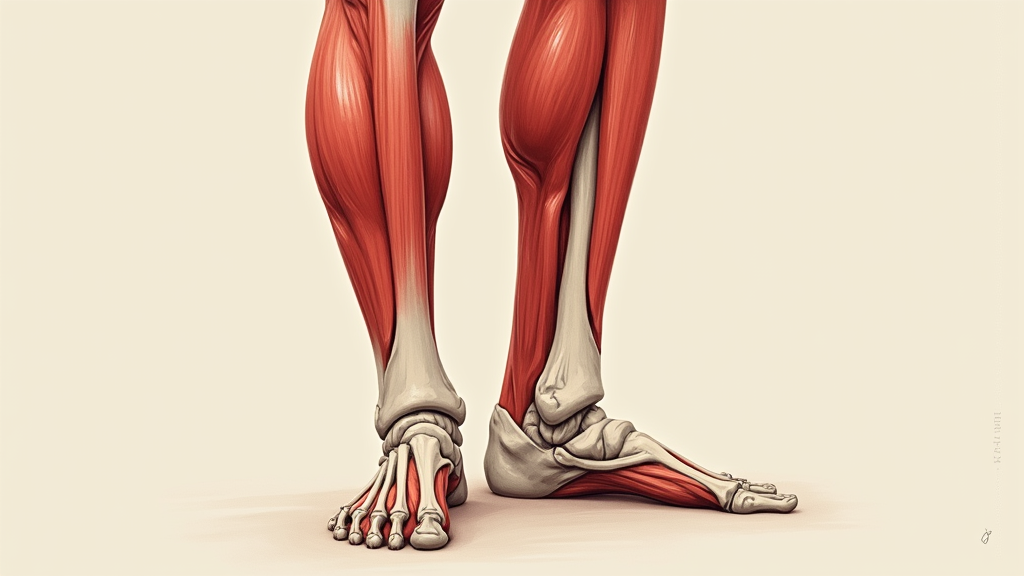Running is my favorite way to stay active and clear my mind, but like any repetitive activity it can sometimes cause discomfort. One of the most common issues faced by new runners is shin splints. I experienced shin splints for a short period many years back. I can attest that it is very uncomfortable and requires informed care to remedy. In this article, I explain what shin splints are, why they happen, and practical tips to reduce your risk. You’ll also find a selection of exercises, stretches, and recovery strategies designed to help manage any pain should it occur. By following these guidelines, you can gradually build strength and enjoy your runs with fewer setbacks.

What Are Shin Splints
Shin splints describe pain along the inner border of your shinbone called the tibia, where muscles meet the bone. The clinical term is “medial tibial stress syndrome” or MTSS. This condition typically arises from small tears or stress in the muscles and connective tissues of the lower leg related to overuse or over strain.
Understanding the underlying causes can lead to better prevention and recovery. Whether you are a beginner or a seasoned runner, being aware of the stress placed on the muscles, bones and connective tissues in your legs is really important. A brief pause to assess and modify your workouts can prevent minor aches from escalating into serious problems.
Are Shin Splints Normal for Beginner Runners
For many new runners, experiencing shin splints is a relatively common occurrence. Since muscles, bones, and tendons are not yet conditioned for the constant impact of running, pain along the shins often occurs. This discomfort should be seen as an early indicator to ease up on your training intensity, not a reason to quit.
Why Am I Getting Shin Splints So Easily
If you find that shin splints occur with minimal effort, several factors might be contributing. A sudden increase in running distance or intensity can leave your muscles struggling to catch up, making the lower legs vulnerable to overuse.
Footwear is another critical factor. Shoes that lack sufficient cushioning or proper arch support fail to absorb the shock of impact effectively. Running on hard surfaces such as concrete or asphalt intensifies the strain on your shins.
In addition, improper running form—like overstriding or misaligned foot landing—adds extra pressure to the lower legs. Recognizing these contributors is really important in order to adjust your training habits and improve your overall biomechanics.
Finally, if you are carrying excess weight this puts greater stress on the lower leg muscles, tendons and bones which can increase the chances of developing shin splints. Every step you take transfers force onto your joints and muscles, if you are overweight this impact will be amplified. As I mentioned above, this is not a reason to quit but an excellent reason to continue. Ease up, employ proper management and pace yourself and the pounds will melt.

How to Prevent Shin Splints When Running
Prevention starts with setting a sensible training pace. Gradually increasing your distance gives your lower leg muscles the opportunity to build strength, endurance and resilience. Begin with shorter, easier runs and slowly increase the intensity to allow your body time to adapt without undue stress.
Alternating running sessions with gentle exercises helps your body build endurance gradually. Over time, as your muscles adapt and strengthen, you can reduce the frequency of shin splints, then eliminate them completely and create a more sustainable running routine.
Proper footwear plays a crucial role; investing in shoes that provide excellent cushioning, and arch support can help absorb some of the impact with every step. Proper fit and, if needed, correction for pronating or supinating can also stabilize your foot strike, further reducing the stress on your lower leg.
Focusing on your form and improving your running technique by landing softly and keeping strides short also makes a significant difference. When possible, switch to softer surfaces like tracks, treadmills or grassy areas to reduce impact and ease the burden on your shins. Combining these measures creates a well-rounded strategy for injury prevention.

Exercises and Stretches to Prevent Shin Splints
Incorporating targeted exercises and stretches into your routine is an effective way to build stronger and more flexible leg muscles.
One useful exercise is the toe-tap drill. While seated, keep your heels on the ground and lift your toes repeatedly – this is called dorsiflexion. This exercise activates and strengthens the muscles at the front of your shin, the tibialis anterior muscle. Heel walking is another method that encourages your shin muscles to work harder by forcing them to engage with every step.
Stretching is equally beneficial. A simple calf (gastrocnemius muscle and soleus muscle) stretch—standing with one foot forward and leaning against a wall—helps elongate tight muscles that contribute to shin splints.
Performing ankle circles and toe raises can promote good flexibility and blood circulation. Integrating these exercises into your warm-up or cool-down routines can improve your performance while lowering the risk of injury.
How to Relieve Shin Splints
When shin splints occur, the first step is to minimize further strain. Transition to lower-impact exercises such as walking, swimming, or cycling allowing the inflamed areas in your legs time to recover until the pain eases. Rest is essential, pushing through the pain is counterproductive because it can exacerbate the injury and potentially stop your workouts completely.
Applying an ice pack to the affected area for 15 to 20 minutes several times a day can help reduce inflammation. Compression sleeves or elastic bandages may also offer additional support and decrease swelling. Be sure these are properly applied and not too tight which could interfere with circulation.
Using a Runner Foam Roller pre or post run can also help to soothe muscle tightness and facilitate muscle recovery.
Elevating your legs after exercise promotes effective blood flow further reducing swelling and inflammation. If discomfort persists, be sure to consult with a health professional before resuming high-intensity exercise.
Wrapping Up
Taking care of your shins is vital for anyone wanting to continue running without interruption. Gradually increasing mileage, selecting the right footwear, and refining your running form are practical ways to prevent shin splints. Moreover, a mix of targeted exercises, proper stretching, and sufficient rest ensures that your legs grow stronger and more resilient with every run.


Shin splints can definitely be a major obstacle for beginners, and I’ve found that proper warm-up and cooldown routines make a huge difference in preventing them. It’s also important to pay attention to the surface you’re running on, as hard pavement tends to exacerbate shin splints. From my experience, switching to more cushioned shoes and incorporating strength training for the lower legs can help build resilience over time. How do you feel about the role of running form in preventing shin splints, particularly for beginners? Could slight adjustments in form, like how the foot lands or strides are taken, make a noticeable difference?
Running form is very important and particularly for beginners. The reason it is especially important for beginners is because when you start running, as with many things, you immediately begin to develop habits. If you get into poorly adapted habits, it will lead to discomfort and possibly injury. At a minimum poor running habits will make your experience less efficient, more difficult and less enjoyable. These are the things that contribute to people not sticking with their goals. And as with most habits, it is more difficult to correct them then it is to just develop beneficial habits at the outset.
It is best to focus, especially in the beginning, on your running form to ensure your foot-strike is even and in alignment and that your strides are also evenly applied and at an optimum length. It is perhaps a little less relaxing
in the early stages of your training as you must concentrate, but the benefits of developing habitually good running form will serve you well and lead to a lifetime of health and fitness through injury free and enjoyable running.
Kevin, this article is a fantastic blend of personal insight and practical guidance. You’ve done a great job making a common yet frustrating issue like shin splints feel manageable and even preventable. The structure is clear, the tone is encouraging, and the advice is genuinely useful, especially for beginners who might feel discouraged early on. I really appreciated how you combined medical explanation with accessible tips and reassured readers that setbacks don’t mean failure. You should be really proud of this, it’s the kind of content that builds trust and keeps people coming back.
Hi Eric,
Thanks for your encouraging review. I sometimes worry that too much clinical talk will be a problem. But it is a habit a long time in the making as I have been an R.N. for over 30 years and a runner for more than 50. So, I love the technical stuff.
My bottom-line goal here is to offer something of value and to promote health and fitness. In my own case I rely heavily on running to maintain myself and I want to promote running because I find it is most efficient and easily accessible form of vigorous exercise I can think of. I do not need to get in the car and go anywhere, it isn’t complicated, and it isn’t expensive. I can simply lace up and go out my own door.
There are things that can set you back as you mention, but through knowledge and practical actionable advice they can all be overcome.
Thanks for reading my article and thanks for the high compliment on my content. It is encouraging and I can always use that.
Kevin